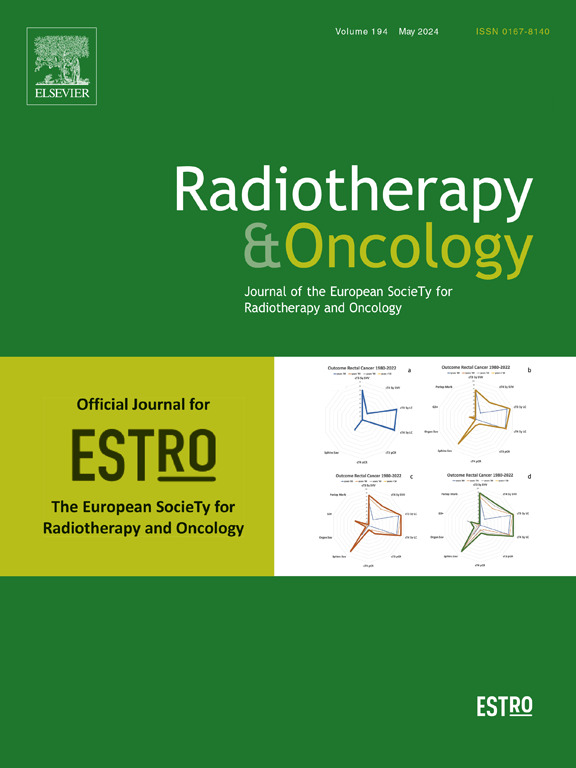Ex vivo brain MRI to assess conventional and FLASH brain irradiation effects
IF 4.9
1区 医学
Q1 ONCOLOGY
引用次数: 0
Abstract
Background and purpose
The FLASH effect expands the therapeutic ratio of tumor control to normal tissue toxicity observed after delivery of ultra-high (>100 Gy/s FLASH-RT) vs. conventional dose rate radiation (CONV-RT). In this first exploratory study, we assessed whether ex vivo Magnetic Resonance Imaging (MRI) could reveal long-term differences after FLASH-RT and CONV-RT whole-brain irradiation.
Materials and methods
Female C57BL/6 mice were divided into three groups: control (non-irradiated), conventional (CONV-RT 0.1 Gy/s), and ultra-high dose rates (FLASH-RT 1 pulse, 5.5 x 10^6 Gy/s), and received 10 Gy of whole-brain irradiation in a single fraction at 10 weeks of age. Mice were evaluated by Novel Object Recognition cognitive testing at 10 months post-irradiation and were sampled at 13 months post-irradiation. Ex vivo brains were imaged with a 14.1 Tesla/26 cm magnet with a multimodal MRI protocol, including T2-weighted TurboRare (T2W) and diffusion-weighted imaging (DWI) sequences.
Results
In accordance with previous results, cognitive tests indicated that animals receiving CONV-RT exhibited a decline in cognitive function, while FLASH-RT performed similarly to the controls. Ex vivo MRI showed decreased hippocampal mean intensity in the CONV-RT mice compared to controls, but not in the FLASH-RT group. Comparing CONV-RT to control, we found significant changes in multiple whole-brain diffusion metrics, including the mean Apparent Diffusion Coefficient (ADC) and Mean Apparent Propagator (MAP) metrics. By contrast, no significant diffusion changes were found between the FLASH-RT and control groups. In an exploratory analysis, compared to controls, regional diffusion metrics were primarily altered in the basal forebrain and the insular cortex after conventional radiation therapy (CONV-RT), and to a lesser extent after flash radiation therapy (FLASH-RT).
Conclusion
This study presents initial evidence that ex vivo MRI uncovered changes in the brain after CONV-RT but not after FLASH-RT. The study indicates the potential use of ex vivo MRI to analyze the brain radiation responses at different dose rates.
用体内外脑磁共振成像评估传统和 FLASH 脑辐照效果
背景与目的:与常规剂量率辐射(convrt)相比,超高剂量率辐射(>100 Gy/s FLASH- rt)治疗后,FLASH效应扩大了肿瘤控制与正常组织毒性的治疗比例。在第一项探索性研究中,我们评估了体外磁共振成像(MRI)是否可以显示FLASH-RT和convr - rt全脑照射后的长期差异。材料与方法将雌性C57BL/6小鼠分为对照组(未照射)、常规组(con - rt 0.1 Gy/s)和超高剂量组(FLASH-RT 1脉冲,5.5 x 10^6 Gy/s),于10周龄接受10 Gy单次全脑照射。在照射后10个月对小鼠进行新物体识别认知测试,并在照射后13个月对小鼠进行采样。用14.1 Tesla/26 cm磁铁对离体大脑进行多模态MRI成像,包括t2加权TurboRare (T2W)和弥散加权成像(DWI)序列。结果认知测试显示,接受convr - rt治疗的动物认知功能下降,而接受FLASH-RT治疗的动物认知功能与对照组相似。体外MRI显示,与对照组相比,convr - rt小鼠的海马平均强度降低,但FLASH-RT组没有。与对照组比较,我们发现多个全脑扩散指标发生了显著变化,包括平均表观扩散系数(ADC)和平均表观传播因子(MAP)指标。相比之下,在FLASH-RT组和对照组之间没有发现明显的扩散变化。在一项探索性分析中,与对照组相比,常规放射治疗(convrt)后,区域扩散指标主要在基底前脑和岛叶皮层发生改变,而在闪光放射治疗(flash - rt)后,区域扩散指标发生了较小程度的改变。本研究提供了初步证据,体外MRI揭示了convr - rt后大脑的变化,而FLASH-RT后没有。该研究表明,在分析不同剂量率下的脑辐射反应时,可能会使用离体MRI。
本文章由计算机程序翻译,如有差异,请以英文原文为准。
求助全文
约1分钟内获得全文
求助全文
来源期刊

Radiotherapy and Oncology
医学-核医学
CiteScore
10.30
自引率
10.50%
发文量
2445
审稿时长
45 days
期刊介绍:
Radiotherapy and Oncology publishes papers describing original research as well as review articles. It covers areas of interest relating to radiation oncology. This includes: clinical radiotherapy, combined modality treatment, translational studies, epidemiological outcomes, imaging, dosimetry, and radiation therapy planning, experimental work in radiobiology, chemobiology, hyperthermia and tumour biology, as well as data science in radiation oncology and physics aspects relevant to oncology.Papers on more general aspects of interest to the radiation oncologist including chemotherapy, surgery and immunology are also published.
 求助内容:
求助内容: 应助结果提醒方式:
应助结果提醒方式:


